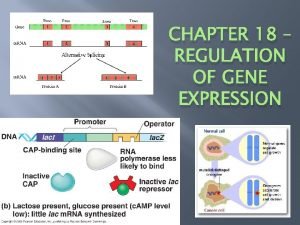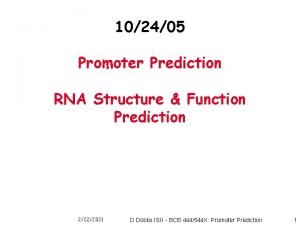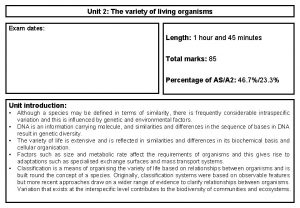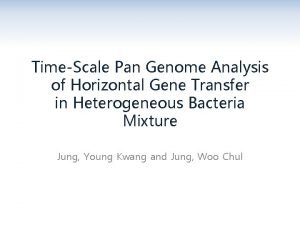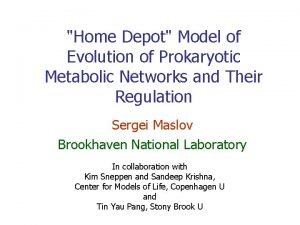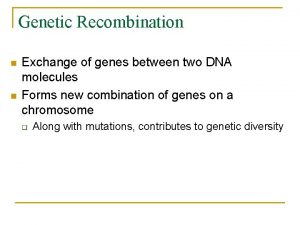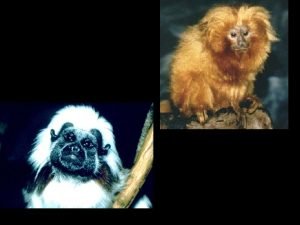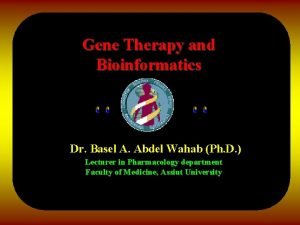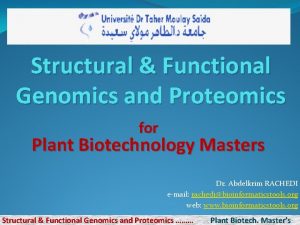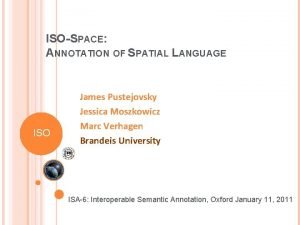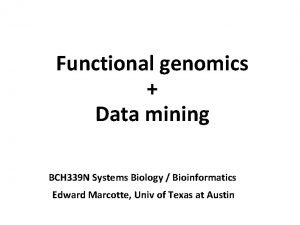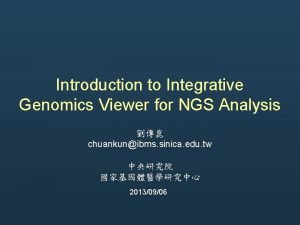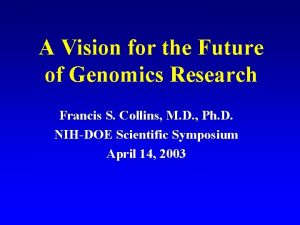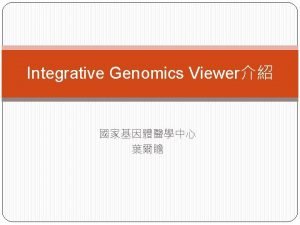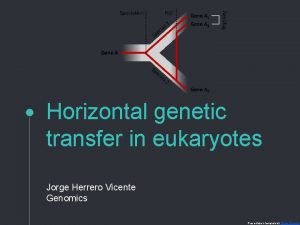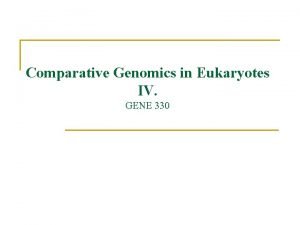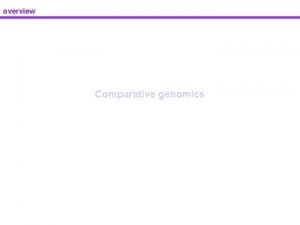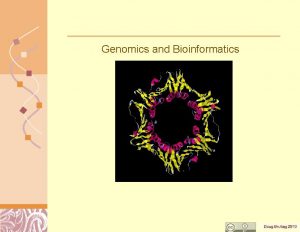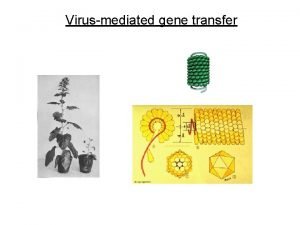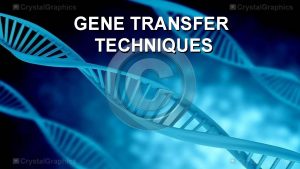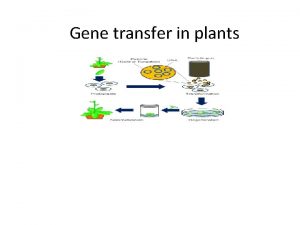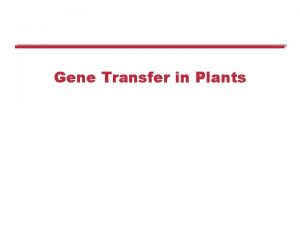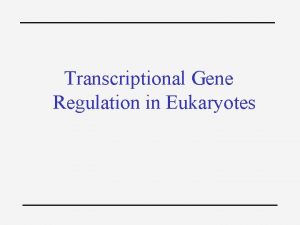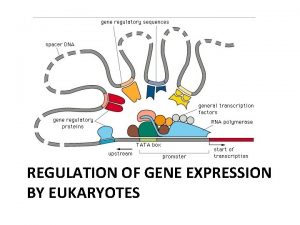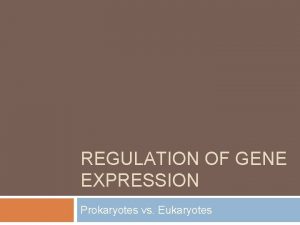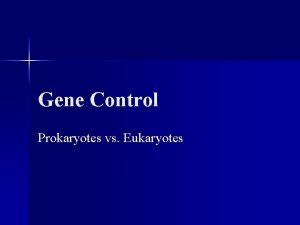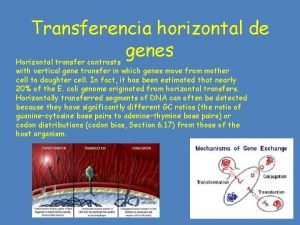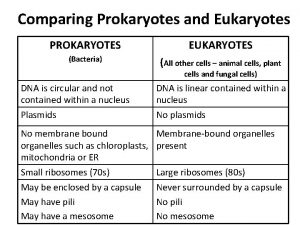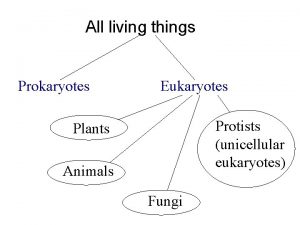HORIZONTAL GENE TRANSFER HGT IN EUKARYOTES Genomics Master


















- Slides: 18

HORIZONTAL GENE TRANSFER (HGT) IN EUKARYOTES Genomics Master in Advanced Genetics Azahara López Jiménez

INDEX • Introduction • HGT conditions • Mechanisms • Implications: o Adaptative advantages o Medicine and biotechnology • Conclusions • Bibliography

HORIZONTAL GENE TRANSFER The movement of genetic information across normal mating barriers, between more or less distantly related organisms, and it is different to the standard vertical transmission of genes from parent to offspring.

HORIZONTAL GENE TRANSFER IN PROKARYOTES TRANSFORMATION CONJUGATION TRANSDUCTION

HORIZONTAL GENE TRANSFER IN EUKARYOTES

Horizontal Gene Transfer (HGT) Eukaryotic evolution Origin of mitochondria and plastids

HGT CONDITIONS CLOSE RELATIONSHIP Donor and recipient; and/or vector mediation interaction POPULATION GENETIC PROCESSES • • • Natural selection Genetic drift Gene flow GENOMIC COMPATIBILITY DETERIORATION Wijayawardena et al. (2013)

“YOU ARE WHAT YOU EAT” CONDUIT MEDIATED HGT IN PLANTS MECHANISMS FOR HGT INFECTIOUS AGENTS TRANSPOSABLE ELEMENTS

1. “YOU ARE WHAT YOU EAT” It suggests that dietary DNA is incorporated into germ cells. Eukaryote 1 Eukaryote 2 Eukaryote 3 ELYSIA CHLOROTICA Gene transfers from food organisms PHOTOSYNTHESIS ALGAL GENES ACQUIRED E. chlorotica feeding on V. litorea Chloroplast Digestive diverticula with chloroplasts v Genes to maintain chloroplast autonomy v Genes to produce photosynthesis

2. CONDUIT MEDIATED HGT IN PLANTS PLASMODESMA HAUSTORIUS Genomic conduit for the flow of pathogens and organic macromolecules between plant host and parasites. Transference of nutrients, water and nucleic acids between the host and parasite. Keeling et al. (2008) The parasite Cuscuta forms intimate connections with the vascular system of its host (Glechoma) haustorius

3. INFECTIOUS AGENTS Viruses have the ability to carry foreign genes and to move them between hosts and parasites act as intergenomic couriers Retroviruses Active and provide fitness benefits Protozoan parasites • • • Leishmania Trypanosoma Babesia Entamoeba Giardia lamblia

4. TRANSPOSABLE ELEMENTS The P elements have spread through Drosophila Dysgenic cross vector Transposable Elements, that have the ability to move in and between genomes, may also have the potential to transport host or parasite genes. The spread of Transposable Elements is mediated by parasites. Proctolaelaps regalis All the other possible crosses produce normal fertile individuals.

IMPLICATIONS ADAPATIVE ADVANATAGES OF HORIZONTAL TRANSFERRED GENES • Adaptation to specific environmental conditions o o Anaerobiosis Nitrogen and iron limitation in marine environments Dictyostelium discoideum 18 genes from bacteria life in soil • Adaptation to parasitism and pathogenesis HGTs that may provide adaptive advantages to protozoan parasites Wijayawardena et al. (2013)

IMPLICATIONS • Red Queen Hypothesis Evolutionary arms race between parasites and their hosts leads to the cyclic development of adaptations and counteradaptations. HGT Wijayawardena et al. (2013) Host genes Parasite to evade host immunosurveillance Host improved defense systems

IMPLICATIONS MEDICINE AND BIOTECNOLOGY Survive without de novo nucleotide synthesis Nucleotide salvage pathway genes from bacteria Absent in the human host Ideal targets drugs against the parasite

CONCLUSIONS • HGT occurs in most lineages of eukaryotes in some degree and probably is an important mechanism in many of them. • Many evidences support the idea that HGT is a major source of genomic continuity among unrelated organisms. • HGT is often delivered by parasite couriers or accepted by parasite recipients.

BIBLIOGRAPHY 1. Andersson, J. O. (2005). Lateral gene transfer in eukaryotes. Cellular and Molecular Life Sciences CMLS, 62(11), 1182 -1197. 2. Andersson JO. 2009. Horizontal gene transfer between microbial eukaryotes. Methods Mol Biol. 532: 473 -87. 3. Boto L. 2014. Horizontal gene transfer in the acquisition of novel traits by metazoans. Proc Biol Sci. 281(1777): 20132450. 4. Doolittle, W. F. (1998). You are what you eat: a gene transfer ratchet could account for bacterial genes in eukaryotic nuclear genomes. Trends in Genetics, 14(8), 307 -311. 5. Hotopp JC et al. 2007. Widespread lateral gene transfer from intracellular bacteria to multicellular eukaryotes. Science. 317(5845): 17536. Keeling PJ, Palmer JD. 2008. Horizontal transfer in eukaryotic evolution. Nat Rev Genet. 9(8): 605 -18. Review. 7. Keeling, P. J. (2009). Functional and ecological impacts of horizontal gene transfer in eukaryotes. Current opinion in genetics & development, 19(6), 613 -619. 8. Loreto EL, Carareto CM, Capy P. 2008. Revisiting horizontal transfer of transposable elements in Drosophila. Heredity. 100(6): 545 -54. 9. Pierce, S. K. , Fang, X. , Schwartz, J. A. , Jiang, X. , Zhao, W. , Curtis, N. E. , & Wang, J. (2011). Transcriptomic evidence for the expression of horizontally transferred algal nuclear genes in the photosynthetic sea slug, Elysia chlorotica. Molecular biology and evolution, 29(6), 1545 -1556. 10. Richardson AO, Palmer JD. 2007. Horizontal transfer in plants. J Exp Bot. 58(1): 1 -9. 11. Wijayawardena BK, Minchella DJ, De. Woody JA. 2013. Hosts, parasites, and horizontal gene transfer. Trends Parasitol. 29(7): 329 -38.

THANK YOU FOR YOUR ATTENTION
 Repressible operon
Repressible operon Prokaryotes vs eukaryotes gene regulation
Prokaryotes vs eukaryotes gene regulation Gene prediction in prokaryotes and eukaryotes
Gene prediction in prokaryotes and eukaryotes Horizontal gene transfer
Horizontal gene transfer Horizontal gene transfer
Horizontal gene transfer Horizontal gene transfer
Horizontal gene transfer Horizontal gene transfer
Horizontal gene transfer Horizontal gene transfer
Horizontal gene transfer Horizontal gene transfer
Horizontal gene transfer Horizontal gene transfer
Horizontal gene transfer Horizontal gene transfer
Horizontal gene transfer Gene by gene test results
Gene by gene test results Chapter 17 gene expression from gene to protein
Chapter 17 gene expression from gene to protein Difference between structural and functional genomics
Difference between structural and functional genomics Essnet qsr
Essnet qsr Difference between structural and functional genomics
Difference between structural and functional genomics Vcf viewer
Vcf viewer A vision for the future of genomics research
A vision for the future of genomics research Igv broad institute
Igv broad institute

